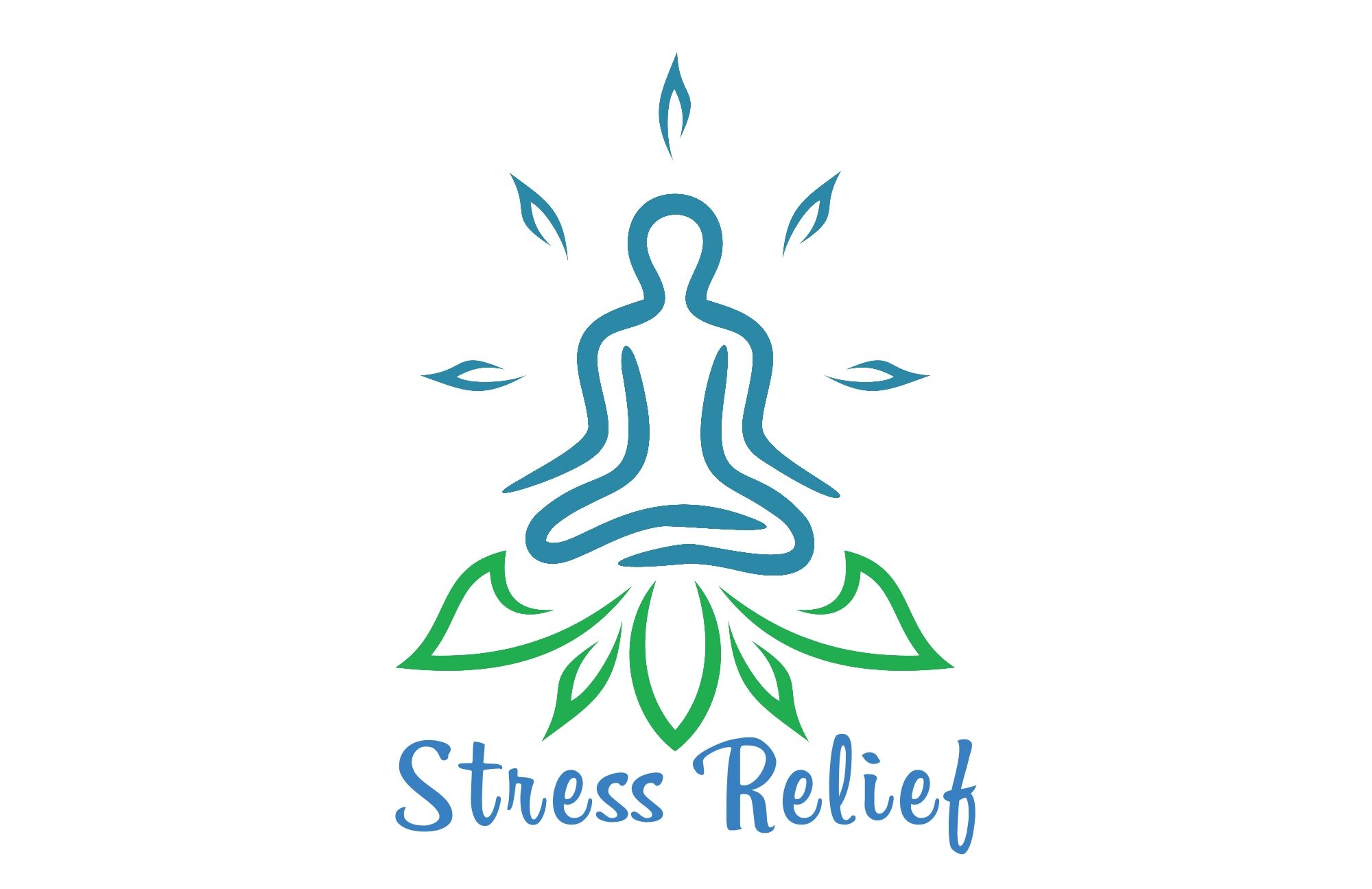I. Introduction
A. Understanding the consequences of shoulder and neck stress
Shoulder and neck stress is a common issue that many people experience due to factors such as sedentary lifestyles, poor posture, and increased screen time. The consequences of this stress can manifest as muscle tension, stiffness, and even pain in the affected areas. It can significantly impact our daily lives, limiting our of motion and causing discomfort or even migraines. It’s crucial to address this issue to prevent further complications and promote overall well-being. In this article we will learn about the exercises to release stress from shoulders and neck.

B. Importance of regular exercise in reducing stress
Regular exercise has numerous benefits for our physical and mental health, and it plays a crucial role in reducing stress in our shoulders and neck. engage in physical activity, our bodies release endorphins, which are natural mood boosters and pain relievers. Exercise also helps increase blood flow to the muscles, promoting relaxation and reducing tension. Incorporating exercises specifically targeting the shoulders and neck into our routine can provide significant relief and help prevent stress-related issues.
C. General Tips for Exercises to Release Stress From Shoulders and Neck
Before diving into the specific exercises, it’s important to keep a few general tips in mind to ensure safe and effective practice:
- Warm-Up: Always begin your exercise routine with a gentle warm-up to prepare your muscles for movement. This can involve light cardio exercises such as walking or jogging in place.
- Proper Form: Pay attention to your posture and technique during each exercise to maximize its benefits. Incorrect form may lead to additional strain or injury.
- Gradual Progression: Start with exercises that feel comfortable and gradually increase intensity or duration over time. Listen to your body’s signals and avoid overexertion.
- Breathing: Focus on deep, controlled breathing while performing exercises. Oxygenating your muscles can aid in relaxation and promote better results.
- Consult a Professional: If you have pre-existing shoulder or neck injuries, it’s advisable to consult a healthcare professional or physical therapist before starting any exercise regimen.
II. Stretching Exercises
Stretching exercises are an excellent starting point to release tension and ease stress in the shoulders and neck. Let’s explore some effective stretches:
A. Upper Trapezius Stretch
1. Technique: Steps to properly stretch upper trapezius
- Start by sitting or standing upright with your shoulders relaxed and your feet shoulder-width apart.
- Place one hand behind your back, grasping the opposite wrist.
- Slowly tilt your head to the side, bringing your ear toward your shoulder on the same side as the hand behind your back.
- Hold the stretch for 15-30 seconds, feeling a gentle pull on the side of your neck and shoulder.
- Repeat on the other side, performing 2-3 sets on each side.
2. Benefits: Relieving tension and promoting relaxation
The upper trapezius stretch effectively targets the muscles that often hold a significant amount of tension in the shoulders and neck. By stretching these muscles, you can experience relief from stiffness and discomfort, promoting a sense of relaxation and enhanced mobility.
3. Precautions: Important considerations to prevent injury
While performing the upper trapezius stretch, it’s vital to maintain proper form and avoid overstretching. Remember to keep your shoulders relaxed and not shrug them toward your ears. If you experience pain or discomfort, ease off the stretch and consult a healthcare professional for further guidance.

B. Levator Scapulae Stretch
1. Technique: Executing the levator scapulae stretch correctly
- Stand or sit up straight with your feet shoulder-width apart.
- Place one hand behind your lower back, grasping the seat of your chair or reaching downward.
- Tilt your head to the opposite side, bringing your ear toward your shoulder.
- Gently apply downward pressure with your hand, increasing the stretch sensation.
- Hold the stretch for 15-30 seconds, then repeat on the other side. Aim for 2-3 sets on each side.
2. Benefits: Alleviating tightness and enhancing flexibility
The levator scapulae stretch primarily targets the muscle responsible for lifting the shoulder blades. Many individuals experience tightness in this area due to prolonged sitting or poor posture. Stretching the levator scapulae can help alleviate tension and improve overall flexibility in the neck and shoulders.
3. Precautions: Safety measures to avoid strain or discomfort
While performing the levator scapulae stretch, it’s important to maintain a gentle and controlled motion. Avoid forcing your head downward or applying excessive pressure with your hand. If you feel any pain or discomfort, modify the stretch or seek guidance from a healthcare professional.
C. Neck Rolls
1. Technique: Step-by-step instructions for performing neck rolls
- Sit or stand comfortably with your feet shoulder-width apart and your shoulders relaxed.
- Slowly tilt your head downward, bringing your chin toward your chest.
- Begin rotating your head in a circular motion, moving from the chin to each shoulder and then to the back until you reach the starting point.
- Repeat the circular motion in the opposite direction.
- Perform 5-10 neck rolls in each direction, taking it slow and focusing on the sensations in your neck.
2. Benefits: Loosening muscles and reducing stiffness
Neck rolls are an effective exercise for loosening up the muscles in the neck and reducing stiffness. The gentle circular motion increases blood flow and relaxes the muscles, promoting a greater range of motion and relieving built-up tension.
3. Precautions: Proper alignment and moderation to prevent strain
During neck rolls, it’s crucial to maintain proper alignment and avoid forcing the movement. Start with small circles and gradually increase the size as your muscles loosen up. If you experience any dizziness or pain, stop the exercise and consult a healthcare professional for guidance.

III. Strengthening Exercises
While stretching exercises help release tension and alleviate stress, incorporating strengthening exercises into your routine can provide long-term relief and enhance posture. Let’s explore some effective strengthening exercises for the shoulders and neck:
A. Shoulder Blade Squeezes
1. Technique: Correct way to perform shoulder blade squeezes
- Begin by sitting or standing upright with your shoulders relaxed.
- Imagine squeezing a pencil or a small ball between your shoulder blades.
- Squeeze your shoulder blades together while maintaining a straight posture.
- Hold the squeeze for 5-10 seconds, then release.
- Repeat the exercise for 10-15 repetitions, aiming for 2-3 sets.
2. Benefits: Strengthening upper back muscles and improving posture
Shoulder blade squeezes primarily target the muscles between your shoulder blades, known as the rhomboids. Strengthening these muscles helps improve posture and provides support to the upper back, reducing the stress placed on the shoulders and neck.
3. Precautions: Avoiding excessive strain on the neck and shoulders
While performing shoulder blade squeezes, it’s important to avoid excessive strain on the neck and shoulders. Focus on engaging the muscles between your shoulder blades without lifting your shoulders toward your ears. If you experience any discomfort, adjust the intensity or consult a healthcare professional for further guidance.
B. Rotator Cuff Exercises
1. Technique: Various exercises to target the rotator cuff muscles
- External Rotation: Stand with your arms by your sides, holding a lightweight dumbbell in each hand. Bend your elbows to 90 degrees and rotate your arms outward, away from your body. Slowly return to the starting position. Repeat for 10-15 repetitions, for 2-3 sets.
- Internal Rotation: Attach a resistance band to a sturdy object at waist height. Stand perpendicular to the band, with your elbow at a 90-degree angle and your forearm across your abdomen. Rotate your forearm inward against the resistance of the band. Repeat for 10-15 repetitions, for 2-3 sets.
2. Benefits: Increasing stability and reducing discomfort
The rotator cuff exercises effectively target the muscles that stabilize the shoulder joint. Strengthening these muscles can improve stability and reduce discomfort or pain associated with shoulder and neck stress.
3. Precautions: Gradual progression and avoiding overexertion
When performing rotator cuff exercises, it’s essential to start with light resistance or weight and gradually progress as your strength increases. Avoid overexertion or using weights that strain your muscles. If you have any concerns, consult a healthcare professional for guidance.
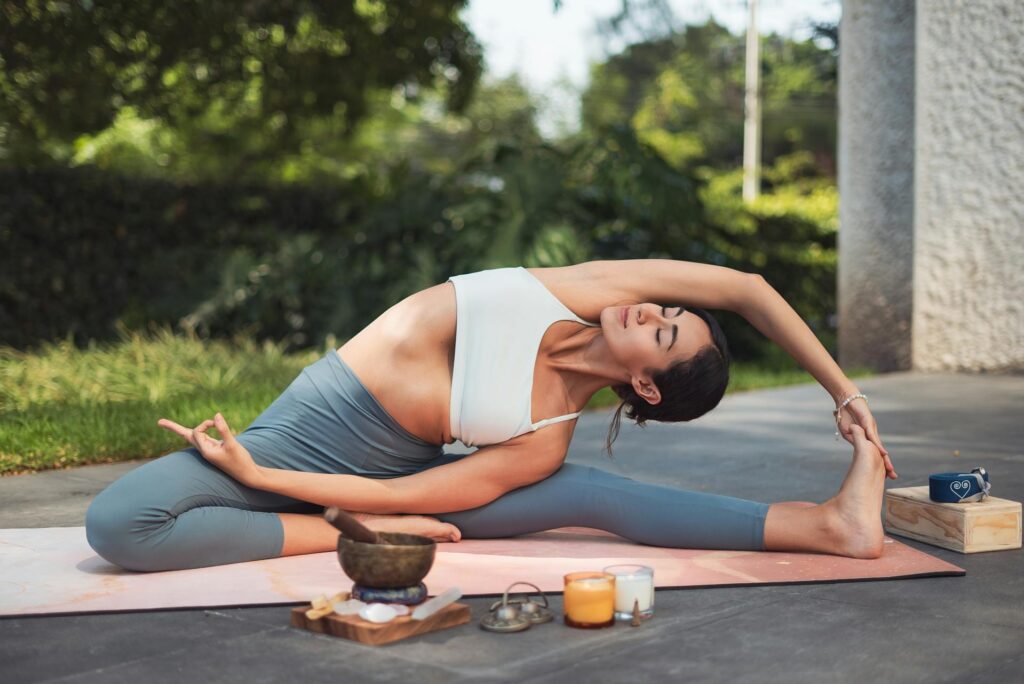
C. Deltoid Strengthening
1. Technique: Effective exercises to strengthen the deltoid muscles
- Dumbbell Shoulder Press: Sit or stand with a dumbbell in each hand, held at shoulder level with your palms facing forward. Extend your arms upward until they are fully extended overhead. Slowly lower the dumbbells back to the starting position. Repeat for 10-15 repetitions, for 2-3 sets.
- Lateral Raises: Stand with a dumbbell in each hand, arms by your sides. Raise your arms out to the sides until they are parallel to the ground. Slowly lower your arms back to the starting position. Repeat for 10-15 repetitions, for 2-3 sets.
2. Benefits: Enhancing shoulder stability and function
Deltoid strengthening exercises target the muscles surrounding the shoulder joint, promoting stability and improved function. Strong deltoid muscles can help alleviate stress on the shoulders and neck, reducing the likelihood of discomfort or injury.
3. Precautions: Using proper form and avoiding excessive weights
When performing deltoid strengthening exercises, it’s crucial to maintain proper form and avoid using weights that are too heavy for your current strength level. Focus on controlled movements, and if you experience any pain or discomfort, modify the exercise or seek guidance from a healthcare professional.
IV. Mind-Body Exercises
In addition to stretching and strengthening exercises, incorporating mind-body exercises into your routine can provide deep relaxation and reduce stress in the shoulders and neck. Let’s explore some beneficial mind-body exercises:
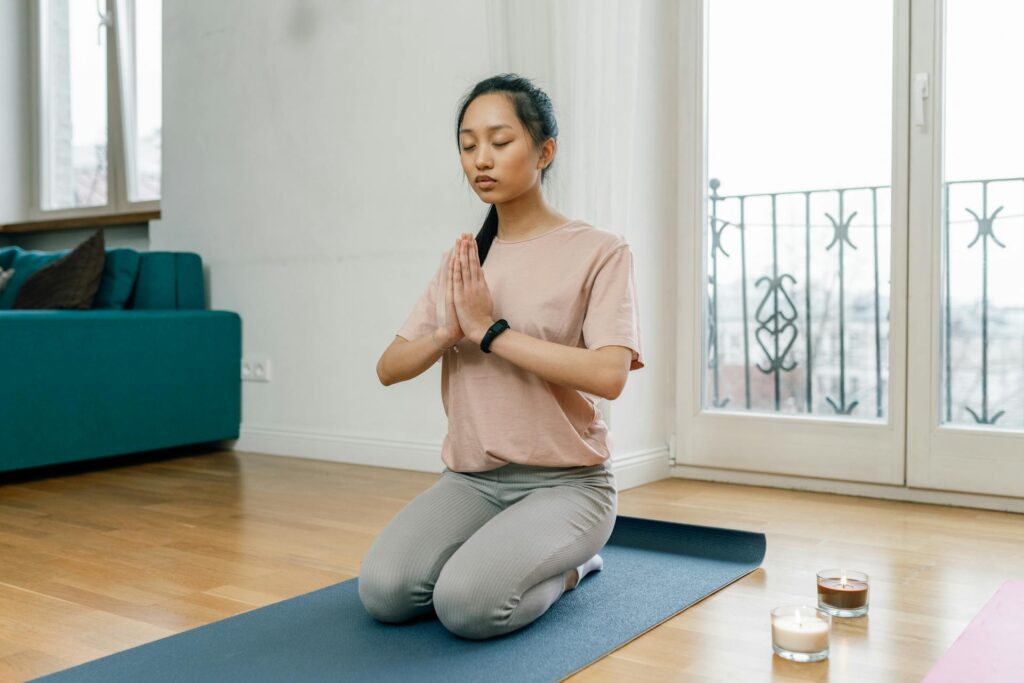
A. Yoga for Shoulder and Neck Relief
1. Technique: Specific yoga postures and sequences
- Child’s Pose (Balasana): Kneel on the floor, sit back on your heels, and lower your upper body forward, resting your forehead on the mat and extending your arms overhead or alongside your body.
- Cat-Cow Pose (Marjaryasana-Bitilasana): Start on all fours with your hands beneath your shoulders and your knees hip-width apart. Round your back toward the ceiling, relax your neck, then arch your spine, lifting your head and tailbone.
- Downward-Facing Dog (Adho Mukha Svanasana): Start on all fours, then press through your hands, straighten your arms, and lift your hips toward the ceiling, forming an inverted V-shape with your body.
2. Benefits: Unwinding tension and promoting overall relaxation
Yoga combines gentle stretches, controlled breathing, and relaxation techniques, making it an ideal practice for releasing tension and promoting overall relaxation in the shoulders and neck. The specific yoga postures mentioned above target the affected areas and help alleviate stress-related discomfort.
3. Precautions: Modifications for different fitness levels and abilities
When practicing yoga, it’s important to listen to your body and modify poses as needed. If you have any injuries or limitations, work within your comfort zone and consult a certified yoga instructor for guidance on modifications that suit your specific needs.
B. Pilates for Improved Posture
1. Technique: Pilates exercises targeting shoulder and neck alignment
- Shoulder Bridge: Lie on your back with your knees bent, feet flat on the floor. Lift your hips off the ground, engaging your glutes and keeping your shoulders grounded. Hold for a few seconds, then lower your hips back down. Repeat for 10-15 repetitions, for 2-3 sets.
- Scapular Retraction: Stand or sit up straight with your arms extended forward at shoulder height. Squeeze your shoulder blades together, then release. Repeat for 10-15 repetitions, for 2-3 sets.
2. Benefits: Correcting postural imbalances and reducing stress
Pilates exercises focus on strengthening the core and improving alignment, making it an effective practice for correcting postural imbalances and reducing stress in the shoulders and neck. These targeted exercises help develop the muscles needed for proper posture, alleviating strain and discomfort.
3. Precautions: Starting with basic exercises and progressing gradually
If you’re new to Pilates, it’s advisable to start with basic exercises and gradually progress to more challenging ones. Focus on proper form and avoid overexertion. If you have any concerns or pre-existing conditions, seek guidance from a certified Pilates instructor.
C. Tai Chi and Qigong
Tai Chi and Qigong are ancient Chinese practices that involve gentle movements and breath control. They are known for their ability to calm the mind and body, making them highly effective exercises for releasing stress from the shoulders and neck.
Technique: Gentle movements for calming the mind and body
In Tai Chi and Qigong, the emphasis is on slow, flowing movements that help to bring the practitioner into a state of relaxation and mindfulness. These movements are designed to be gentle on the body, with a focus on deep breathing and proper body alignment.
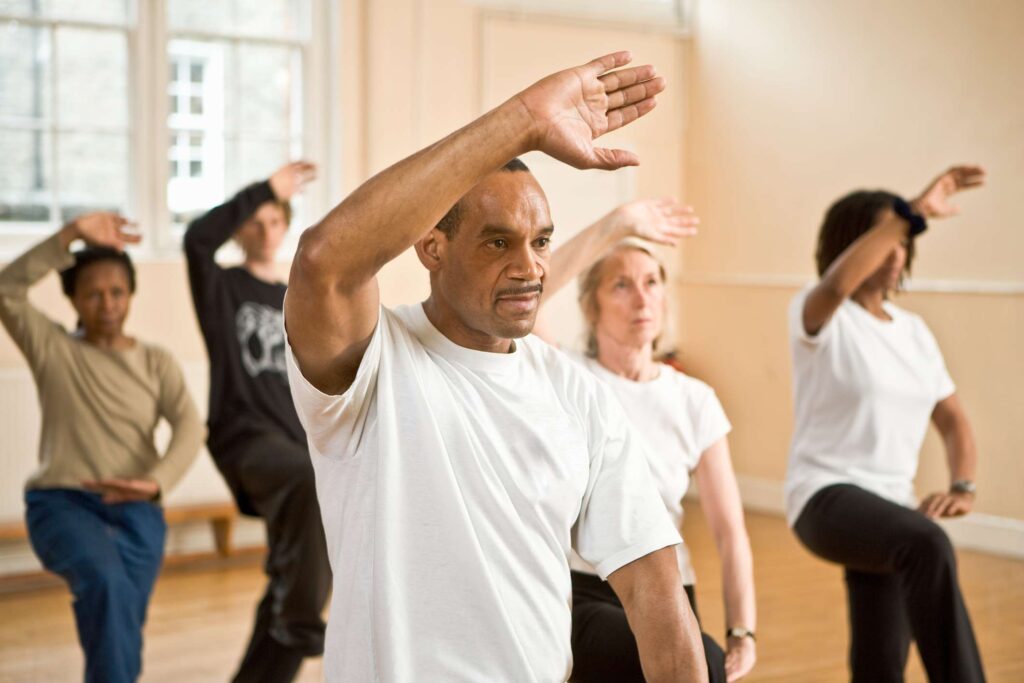
Benefits: Reducing muscle tension and promoting mindfulness
By practicing Tai Chi and Qigong, individuals can reduce muscle tension in the shoulders and neck. The slow and controlled movements help to stretch and strengthen the muscles, improving flexibility and alleviating any built-up tension. Additionally, the emphasis on deep breathing and mindfulness promotes relaxation, helping individuals to let go of stress and anxiety.
Precautions: Following a certified instructor’s guidance for proper form
While Tai Chi and Qig are generally safe exercises, it is important to learn from a certified instructor to ensure proper and technique. This is especially crucial for individuals with pre-existing shoulder or neck injuries, as incorrect movements may exacerbate these conditions. By learning from an experienced instructor, individuals can minimize the risk of injury and maximize the benefits of these exercises.
V. Other Techniques and Self-Care Tips
While Tai Chi and Qigong are excellent exercises for releasing stress from the shoulders and neck, there are also other techniques and self-care tips that can provide relief.
A. Self-Massage Techniques
Self-massage techniques can be a great way to relieve muscle knots and increase blood circulation in the shoulders and neck.
Technique: Simple self-massage techniques for neck and shoulders
- Start by gently massaging the base of your skull with your fingertips. Apply circular motions and gradually move down towards the neck.
- Use your thumb and index finger to squeeze and release the muscles along the sides of your neck.
- Place a tennis ball or foam roller between your upper back and a wall. Lean against the ball or roller and slowly roll it up and down to massage the muscles in your upper back and shoulders.
- Finish by gently massaging your shoulders with upward strokes towards the neck.
Benefits: Relieving muscle knots and increasing blood circulation
Self-massage techniques can help to relieve muscle knots that often contribute to shoulder and neck pain. By applying pressure and gentle manipulations, these techniques can release tension and improve blood circulation, promoting faster recovery and relaxation.
Precautions: Avoiding excessive pressure and seeking professional help when needed
While self-massage can provide temporary relief, it is important to avoid applying excessive pressure, especially if you have pre-existing injuries or conditions. If you experience severe or persistent pain, it is advisable to seek professional help from a massage therapist or healthcare provider.
B. Heat and Cold Therapy
Heat and cold therapy can be used to relax muscles and reduce inflammation in the shoulders and neck.
Technique: Proper use of heat and cold therapy for pain relief
- For heat therapy, use a heating pad or a warm towel and apply it to the affected area for about 20 minutes. The heat helps to increase blood flow, relax muscles, and soothe pain.
- For cold therapy, wrap ice packs or frozen gel packs in a thin towel and apply them to the shoulders and neck for 15-20 minutes. Cold therapy can help to reduce inflammation and numb pain.
Benefits: Relaxing muscles and reducing inflammation
Both heat and cold therapy provide relief by relaxing muscles and reducing inflammation in the shoulders and neck. Heat therapy improves blood flow, while cold therapy reduces swelling and numbs pain, allowing for greater comfort and mobility.
Precautions: Timing and duration considerations for optimal results
It is important to use heat and cold therapy appropriately to avoid any adverse effects. Limit the use of heat therapy to 20 minutes at a time and allow your skin to cool down between sessions. Cold therapy, on the other hand, should also be used in moderation to prevent skin damage. If you have any pre-existing conditions or concerns, consult a healthcare professional before using heat or cold therapy.
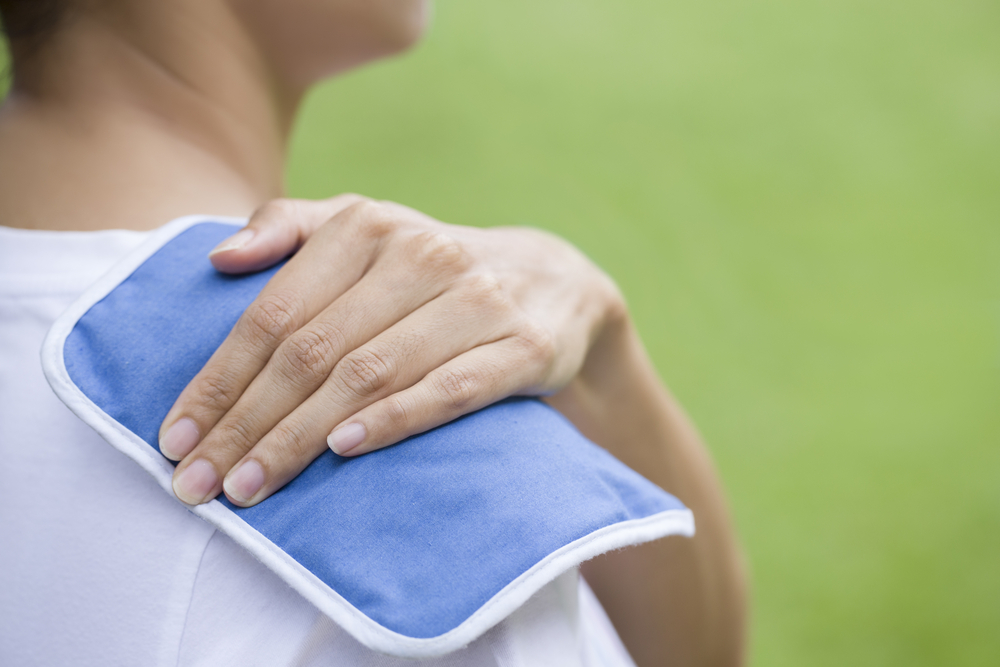
C. Ergonomics and Posture Correction
Maintaining proper ergonomics and correcting posture can greatly benefit the shoulders and neck in the long run, preventing future strain and maintaining a healthy alignment.
Technique: Implementing ergonomic adjustments and correcting posture
- Ensure that your workplace is properly set up with an ergonomic chair, adjustable desk, and appropriate lighting. This will help to reduce strain on your shoulders and neck.
- Sit up straight and avoid slouching. Keep your shoulders relaxed and aligned with your ears, and your chin parallel to the ground. Consider using a lumbar support cushion or a rolled-up towel to maintain the natural curve of your spine.
- Take regular breaks to stretch and move around. Perform simple stretches, such as neck rolls and shoulder shrugs, to relieve any tension that may build up throughout the day.
Benefits: Preventing future strain and maintaining a healthy alignment
Practicing proper ergonomics and correcting posture can significantly reduce the risk of developing chronic shoulder and neck pain. By maintaining a healthy alignment, you minimize the strain on these areas and promote overall musculoskeletal health.
Precautions: Consistency in ergonomic practices and adapting workstations
While implementing ergonomic adjustments and correcting posture is essential, it is equally important to maintain consistency and continually adapt your workstations to your needs. Regularly assess your setup and make necessary changes to ensure optimal comfort and support.
VI. Summary
In summary, relieving stress from the shoulders and neck is crucial for overall well-being and pain management. Incorporating exercises such as Tai Chi and Qigong, self-massage techniques, heat and cold therapy, as well as practicing proper ergonomics and posture correction can provide significant relief and prevent future issues.
VII. FAQs (Frequently Asked Questions)
A. Can these exercises be performed by individuals with pre-existing shoulder or neck injuries?
These exercises can generally be performed by individuals with pre-existing shoulder or neck injuries. However, it is important to consult with a healthcare professional or a certified instructor before starting any exercise regimen. They can provide personalized guidance and modifications to ensure safety and prevent further injury.
B. How frequently should these exercises be done to achieve the desired results?
The frequency of these exercises may vary depending on individual needs and preferences. It is recommended to start slowly and gradually increase the frequency over time. Consistency is key, and it is generally beneficial to practice these exercises at least a few times per week to achieve the desired results.
C. Are there any specific exercises to avoid in case of severe pain or discomfort?
In case of severe pain or discomfort, it is advisable to avoid any exercises that worsen your symptoms. Listen to your body and modify or skip exercises that cause excessive pain. If the pain persists or becomes unbearable, seek medical attention to determine the underlying cause and receive appropriate treatment.
Remember, incorporating a variety of exercises and self-care techniques is important for a holistic approach to releasing stress from the shoulders and neck. Find what works best for you and make these exercises a regular part of your daily routine for lasting relief.
